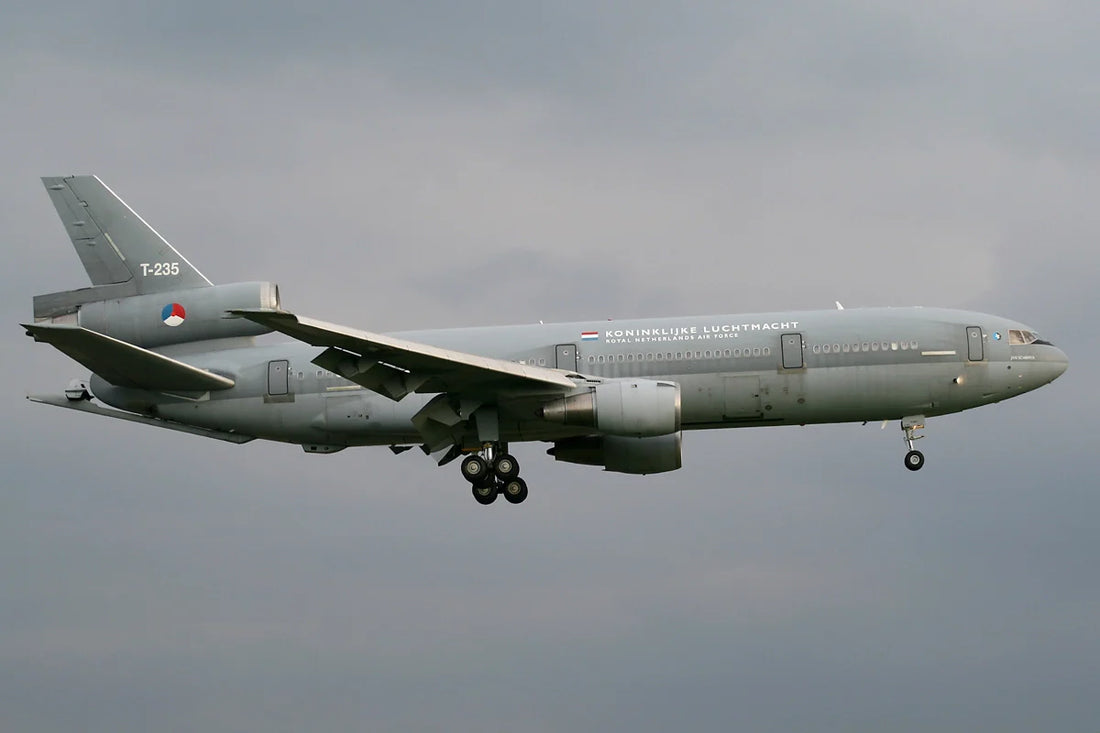A tribute-style exploration of the KC-10 Extender: its design, refueling systems, operational achievements, and the legacy that made it the unsung giant of global air power.
The sun dips below the horizon, bathing a vast, empty expanse of ocean or desert in shades of bruised violet and burning orange. High above the globe, a lone aircraft slices through the troposphere, its shadow invisible to the world below. This is not a bomber or a fighter, but a lifeline — a giant winged gas station carrying the silent promise of global reach. This is the KC-10 Extender, an aircraft whose history is steeped not in fire and fury, but in the quiet, indispensable drama of logistical mastery.
To simply call the KC-10 Extender a tanker is to define a heart by its engine. It is an act of reduction that misses the profound, transformative role this aircraft played in shaping modern American air power. It became the vital artery connecting continents, enabling missions that defined decades of international security. The sight of the KC-10 aircraft, with its triple-engined silhouette, became an assurance to crews across the globe: you are not alone, and your mission will not fail for lack of fuel.
The Genesis of Global Reach: Necessity and the DC-10 Lineage
The story of the KC-10 begins not with military design specifications, but with a commercial need for range and efficiency. In the 1970s, as the U.S. Air Force looked to enhance its aging tanker fleet (primarily the venerable KC-135 Stratotanker), a new requirement emerged: a tanker that could carry massive amounts of fuel and cargo, operating independently across great distances. The existing fleet was excellent, but America's commitment to maintaining a swift global response demanded something more.
The answer lay in adapting a proven civilian airframe: the McDonnell Douglas DC-10 wide-body trijet. The decision to base the military tanker on the DC-10 was a masterstroke in military logistics. It immediately leveraged a robust, established civilian design known for its endurance and large carrying capacity. The military variant, the McDonnell Douglas KC-10, inherited the DC-10’s immense fuselage and three powerful General Electric CF6 turbofan engines, setting it apart from its smaller, four-engined predecessors. It entered service in the early 1980s, immediately introducing a new level of versatility and endurance to the Strategic Air Command.

McDonnell Douglas DC-10
A Masterpiece of Logistics: KC-10 Design and Technical Might
The KC-10 design is a testament to the concept of multifunctionality. Its wide-body fuselage was ingeniously utilized to offer a true dual-role capability unmatched at the time. Unlike single-role tankers, the Extender was built to simultaneously haul critical equipment and deliver fuel, effectively acting as an enormous airborne force-multiplier.
Technically, the KC-10 capabilities are impressive. With a maximum takeoff weight exceeding 590,000 pounds, it is a giant of the skies. Its three high-bypass turbofan engines provide the thrust and efficiency required for its extended missions. But the true genius lies in its internal plumbing. The aircraft was fitted with enormous fuel tanks within its lower fuselage and cargo compartments, giving it a staggering maximum fuel capacity of over 356,000 pounds. This volume allows it to perform two critical roles: offloading enough fuel to keep a flight of fighters operational across an ocean, or carrying enough for a massive self-deployment over its own extraordinary KC-10 range.
The Heart of the Mission: The KC-10 Refueling System
The essence of the KC-10 tanker lies in its sophisticated fuel transfer equipment. This is where the machine distinguishes itself, not just from its civilian counterpart, but from most other aerial refueling platforms.
The KC-10 refueling system is unique in its flexibility, incorporating both of the primary methods used by the U.S. and its NATO allies: the flying boom and the probe-and-drogue. The primary system is the advanced McDonnell Douglas (later Boeing) air refueling boom, operated by a boom operator lying flat at the rear of the aircraft. This operator, using precise controls, guides the telescoping boom into the receiving aircraft’s receptacle — a delicate, high-stakes ballet performed at hundreds of miles per hour.
Crucially, the KC-10 also came standard with two independent probe-and-drogue stations (one centerline drogue and one on a wing pod). This dual capability means the KC-10 can refuel virtually any friendly aircraft in the world — from a massive B-2 Spirit bomber using the boom, to a U.S. Navy F/A-18 or a NATO fighter using the drogue. This versatility made the KC-10 Extender the go-to aircraft for complex, multinational deployments.
Forged in Fire: The KC-10 in Operation Desert Storm
The KC-10 in Operation Desert Storm is where the aircraft truly cemented its legendary status. Before the first coalition fighter could drop a bomb on Baghdad, the Extender had to build the air bridge.
In the massive buildup of forces required for the 1991 Gulf War, the KC-10 became indispensable. It was instrumental in ferrying fighters, transports, and bombers from continental U.S. bases all the way to Saudi Arabia. It was common for a single KC-10 to depart loaded with cargo, fly overseas, offload its cargo, and then immediately begin air refueling operations to support combat missions.

Operation Desert Storm Map(1991)
The sheer, grinding endurance of the Extender crews and their machines was the logistical backbone of the air campaign. During the war, KC-10s flew thousands of sorties, logging more than 31,000 hours and delivering over 125 million pounds of fuel. The drama was often subtle — a mid-air rendezvous over pitch-black, hostile territory, where one aircraft’s survival depended on the reliable delivery of fuel from the other. The success of the air campaign, and the speed of the coalition’s victory, was inextricably tied to the KC-10 Extender’s unparalleled ability to extend the reach and endurance of every other aircraft in the inventory.
The Silent Global Sentinel: A KC-10 Legacy of Resilience
The KC-10 legacy spans four decades of continuous service, from the Cold War's end through the Global War on Terror. Its service history is a mosaic of massive, strategic deployments: keeping B-52s airborne during operations, enabling continuous fighter patrols, and ensuring humanitarian relief could be delivered anywhere. It is an aircraft of tireless resilience, often the first to arrive and the last to leave a theatre of operations.
The men and women who flew and maintained the KC-10 aircraft speak of its toughness and reliability with a respect usually reserved for combat machines. They mastered the complex procedures required to manage its fuel load and cargo, understanding that their work was the unseen foundation upon which global air power rested. In a sense, the KC-10 became a cultural symbol within the Air Force—a reminder that the most essential roles are often the ones performed in the quiet darkness, far from the spotlight.
Honoring an Aviation Workhorse
As the years advanced, the KC-10’s role has transitioned toward retirement, slowly passing the torch to next-generation tankers. But its place in history is permanent. The KC-10 Extender defined an era of mobility, providing the strategic flexibility the U.S. military needed to respond to any threat, anywhere in the world. Its sheer capacity, coupled with its dual-mission design, fundamentally changed the landscape of military logistics.
The KC-10 design and its vast KC-10 capabilities will forever be remembered as the triumph of wide-body air superiority. The memory of its tireless service, its powerful engines pushing against time and distance, and the skillful crews who operated its intricate KC-10 refueling system—all these elements form a rich chapter in modern aviation history. The KC-10 was more than just metal and fuel; it was the promise of mission success, the silent sentry whose powerful KC-10 range made the globe a smaller, more accessible place for American air power.
Honor the unsung hero of global air power
If you, like the crews and commanders who depended on its vital service, respect the resilience and massive capability of this unique trijet, bring its legacy home. Explore our exclusive collection of hand-crafted KC-10 model aircraft at Premium Wood Art. Each detailed KC-10 model aircraft is a testament to the engineering and sacrifice that defined its unparalleled four decades of service.
✈️ Bring Aviation History Home
